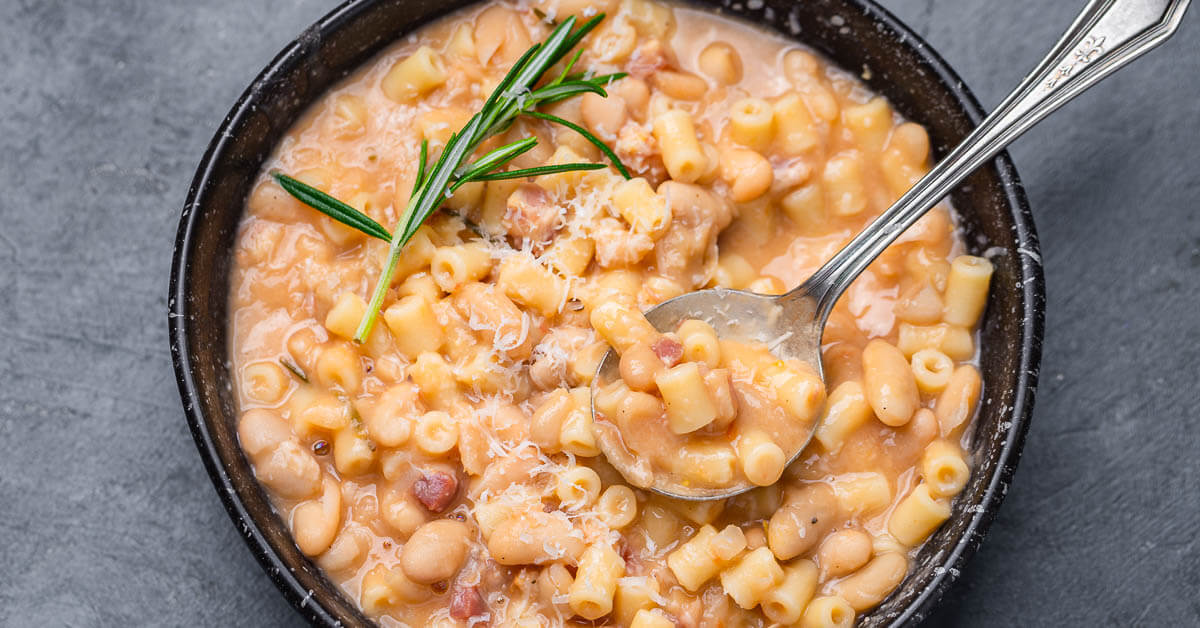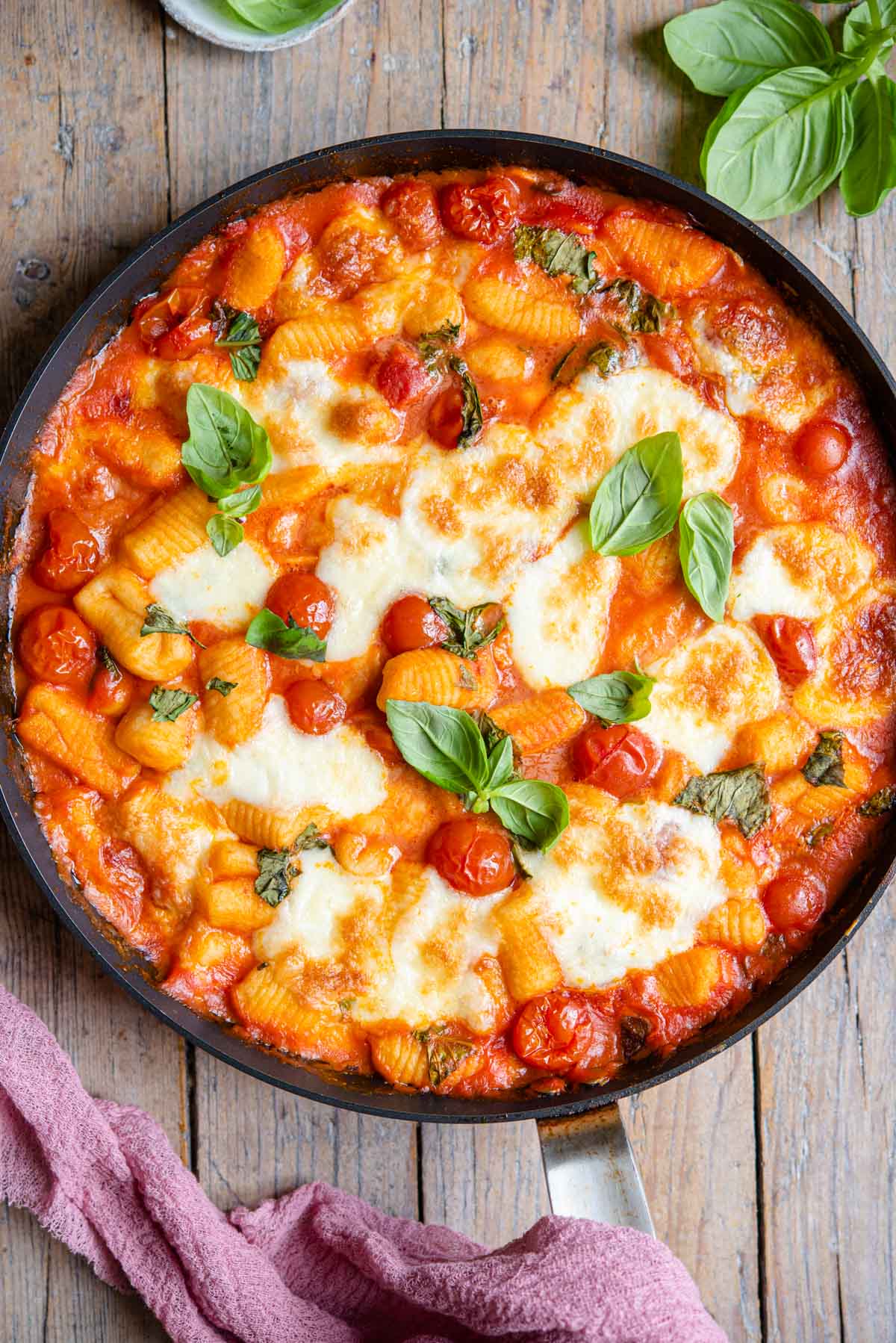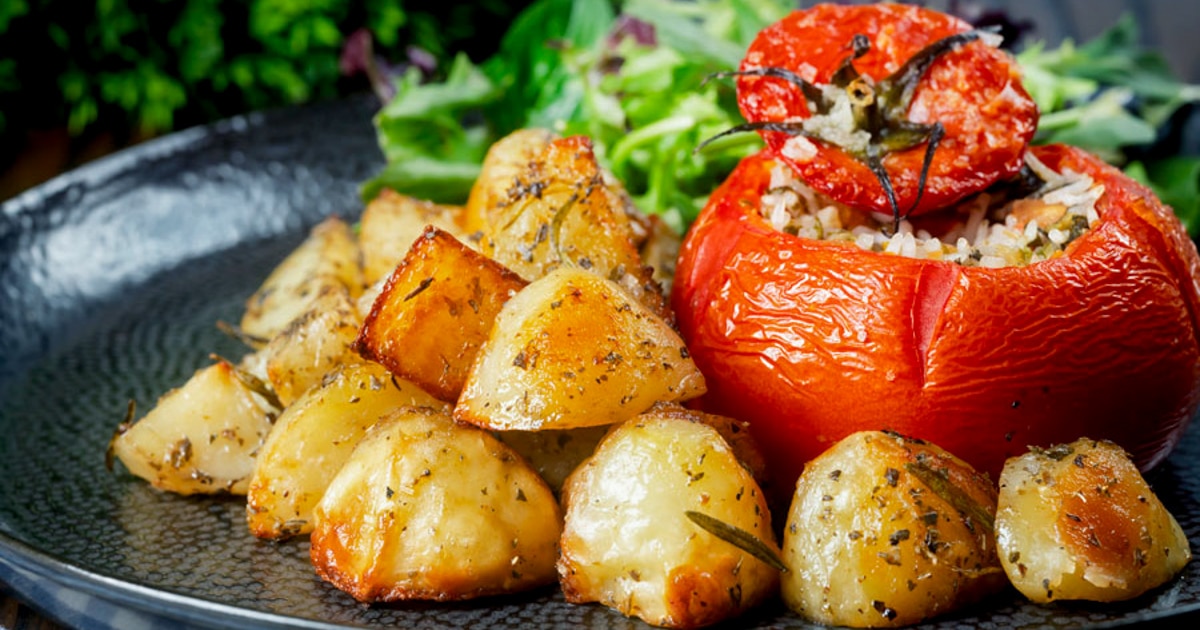Many people don't know it, but the majority of traditional Italian recipes are mostly vegetarian. This is because Italian cuisine was born from peasant traditions, where meat was sparse and rare. From classic pasta dishes to hearty soups and stews, Italian cuisine offers a wide variety of flavorful options for vegetarians.

One of my personal favorite vegetarian Italian recipes is homemade potato gnocchi. Passed down by my Italian grandmother, this recipe is a family favorite and always a hit at dinner parties. Another favorite is pumpkin risotto, which is a comforting and flavorful dish that is perfect to bring to your dinner table on chilly evenings. Whether you're a seasoned cook or just starting out, there are plenty of vegetarian Italian recipes to choose from that are easy to follow and sure to please.
Make sure to check also the collection of best vegetarian pasta recipes and the best baked pasta recipes packed with veggies.
Jump to:
- History and Ingredients of Italian Cuisine
- ★ SAVE THIS RECIPE ★
- Vegetarian Italian Recipes
- Appetizers:
- Pasta Dishes:
- Pizza and Focaccia:
- Soups and Stews:
- Salads:
- Risotto:
- Gnocchi:
- Main Courses:
- Savory Pies:
- Vegetarian Traditional Cooking in Different Regions of Italy
- The "Slow Food" in Italy: A Celebration of Quality Ingredients
History and Ingredients of Italian Cuisine
Italian cuisine is one of the most popular cuisines in the world and for good reason. It is known for its simple yet flavorful dishes that use fresh, high-quality ingredients.
Historical Background
Italian cuisine has a rich and diverse history that dates back to ancient times. The Etruscans, Greeks, and Romans all played a significant role in shaping the traditional dishes. During the Renaissance, Italian cooking became more refined and sophisticated, with a focus on fresh ingredients and simple preparations.
Today, Italian food is known for its regional diversity, with each region having its own unique culinary traditions. Some of the most famous Italian dishes include pizza, pasta, risotto, and lasagna.
Key Ingredients
Italian cuisine is characterized by its use of fresh, high-quality ingredients. Some of the key ingredients in Italian recipes include:
- Olive oil: Olive oil is a staple in Italian cuisine and is used for everything from cooking to dressing salads. Most of the Italian olive oil is produced in Tuscany and Apulia regions.
- Tomatoes: Tomatoes are a key ingredient in many Italian dishes, including pizza, pasta, and bruschetta. Even though they're considered a base in many Italian traditional recipes, tomatoes have only been imported into Italy only in 1540.
- Cheese: Italian is known for its variety of cheeses, including mozzarella, parmesan, and ricotta. You may think France has the most cheeses, but actually, Italy has 487 different cheese varieties, while France has only 246.
- Herbs: Italian cuisine relies heavily on fresh and dried herbs such as basil, oregano, and rosemary to add flavor to dishes.
- Pasta: Pasta is a staple in Italy and comes in a variety of shapes and sizes. There are over 300 different types of pasta shapes.
By using fresh, high-quality ingredients and simple preparations, Italian dishes can be both healthy and flavorful.

Vegetarian Italian Recipes
There are many delicious Italian vegetarian recipes that are both filling and flavorful. Here are some of my favorite easy Italian recipes, from appetizers to pasta dishes to soup, savory pies, and more:

Appetizers:
1. Bruschetta al Pomodoro: Grilled bread rubbed with garlic, topped with diced tomatoes, fresh basil, olive oil, and sometimes mozzarella.
2. Caprese Salad: Fresh mozzarella, tomatoes, and fresh basil, drizzled with olive oil and sometimes balsamic vinegar.
3. Carciofi alla Romana: Artichokes stuffed with herbs and breadcrumbs, simmered in white wine and olive oil.
4. Stuffed Zucchini Blossoms: The delicate and beautiful zucchini or squash flowers are stuffed with a mix of cheese and then fried to perfection.
5. Fried sage: Crispy battered fried sage leaves are a classic appetizer in Tuscany and other regions.

Pasta Dishes:
6. Cacio e Pepe: A creamy cheese sauce with lots of black pepper envelops thick spaghetti, Tonnarelli, or Pici pasta, for a scrumptious dish.
7. Pappardelle ai Funghi: Flat pappardelle pasta served with a rich wild mushroom sauce, perfect for fall.
8. Spaghetti Aglio e Olio: Spaghetti tossed with sautéed garlic in olive oil, red pepper flakes, and often garnished with parsley.
9. Penne all'Arrabbiata: Penne pasta in a spicy tomato sauce with chili and garlic.
10. Fettuccine Alfredo: Creamy pasta made from butter, and freshly grated Parmesan cheese. There's no heavy creamy in the traditional Roman dish.
11. Lasagna ai Carciofi: Lasagna layers with artichoke hearts, mozzarella cheese, and béchamel sauce.
12. Trofie al Pesto: Classic basil pesto sauce is much better homemade! This traditional recipe from Genova, Liguria, is a classic combination of deliciousness.
13. Pasta e Patate: A creamy cheesy sauce made with starchy potatoes cooked until creamy in a flavorful stock, then adding melted Provolone for a melted bite of heaven.

Pizza and Focaccia:
15. Pizza Bianca or Focaccia Genovese: A white soft focaccia with lots of olive oil, salt, and sometimes rosemary or other toppings. No tomato sauce.
14. Pizza Margherita: Simple vegetarian pizza topped with simple tomato sauce, fresh mozzarella, fresh basil, and olive oil.
16. Focaccia di Recco: Thin focaccia bread, stuffed with melted Recco cheese, similar to Stracchino cheese.
17. Panzerotti: Fried small calzones made with pizza dough stuffed with tomatoes and mozzarella, or other stuffings similar to pizza.
18. Focaccia Barese: Soft focaccia topped with roasted tomatoes and olives.

Soups and Stews:
19. Ribollita: Thick Tuscan soup made from old bread, kale, cannellini beans, and vegetables.
20. Minestrone: A hearty vegetable soup, often blended until smooth and served with pasta or rice. Real Italian Minestrone has usually a green-orange color, rather than red.
21. Pappa al Pomodoro: This stew of tomatoes and stale bread, makes this incredibly flavorful and simple Tuscan dish. Often served warm or at room temperature.
22. Pasta e Fagioli: Rich creamy white beans soup, served with pasta and cheese. Pasta e fagioli is a classic Italian dish.
23. Zuppa di Ceci: Chickpea soup, often seasoned with rosemary and potatoes, and served with pasta.
24. Zuppa di Legumi: A warm legumes and grains soup, often with carrots, celery, and small pasta. A healthy and perfect comfort food.

Salads:
25. Insalata di carciofi e grana: A fresh and zesty salad with raw shaved artichokes, lemon juice, and chunks of Parmigiano cheese.
26. Panzanella: A Tuscan salad made of soaked stale bread cubes, tomatoes, onions, and often cucumbers.
27. Insalata di Rucola e Parmigiano: A simple recipe for a salad of arugula leaves topped with shaved Parmesan.
28. Insalata di Finocchi e Arance: A refreshing salad with sliced fennel and orange segments.
29. Insalata di Farro: A grain salad with spelt, veggies, and often cheese or olives.

Risotto:
30. Risotto alla Milanese: Saffron-infused risotto, often topped with grated Parmesan. Traditionally served with veal bone marrow.
31. Risotto agli Asparagi: A spring risotto with flavorful asparagus and creamy Parmesan.
32. Risotto ai Funghi: Creamy rice dish cooked with vegetable broth and mixed with sautéed fresh mushrooms.
33. Risi e Bisi: Italian rice and peas recipe that is a real comfort food, a soft and creamy mix between a risotto and a soup.
34. Risotto al Limone: Creamy risotto with a bright lemon flavor. A perfect summer zesty dish.
35. Risotto al Parmigiano: A rich creamy risotto blended with Parmesan cheese. A classic recipe for comfort food.
36. Risotto al Pomodoro: Fresh tomatoes mixed with melted butter, make this risotto a simple yet delicious dish.
37. Risotto alla Zucca: One of my favorite fall dishes, creamy risotto with bright orange pumpkin. A delicious fall main course.

Gnocchi:
38. Gnocchi Burro e Salvia: Soft potato dumplings served with a classic butter and sage sauce.
39. Gnocchi alla Romana: Semolina-based gnocchi, often baked with butter and cheese.
40. Gnocchi ai Quattro Formaggi: Potato gnocchi in a creamy blue cheese sauce.
41. Gnocchi alla Sorrentina: Potato gnocchi baked with tomato sauce, mozzarella, and basil.
42. Gnudi ai Spinaci e Ricotta: Soft dumplings made from spinach and ricotta, often served with tomato or butter-sage sauce.

Main Courses:
43. Eggs in Purgatory: Soft eggs cooked in a flavorful and slightly spicy tomato sauce.
44. Melanzane alla Parmigiana: Layers of fried eggplant, tomato sauce, mozzarella, and Parmesan, baked to perfection.
45. Peperoni Ripieni: Bell peppers stuffed with a mixture of rice, cheese, and sometimes other vegetables.
46. Polenta con Funghi e Formaggio: Soft cornmeal polenta topped with sautéed mushrooms and cheese.
47. Pomodori ripieni: A summer classic dish. Roasted large tomatoes stuffed with rice and vegetables.

Savory Pies:
48. Torta Pasqualina: A traditional Easter pie made with spinach, ricotta, and eggs.
49. Erbazzone: A savory pie from Emilia-Romagna filled with Swiss chard, onions, and often Parmesan.
50. Torta di Cipolle: A savory onion pie or tart typical from Apulia region, often enriched with cheese, anchovies, and olives.
51. Nchiambara: It's a traditional dish from Calabria region, a sort of red onion Frittata but without eggs.
52. Cecina or Farinata: A thin crispy pancake made with chickpea flour. This easy recipe is traditional from Tuscany and Liguria.

Vegetarian Traditional Cooking in Different Regions of Italy
The Italian peninsula, rich in its geographical diversity from the snowy Alps to the sun-bathed shores of Sicily, has given rise to a culinary tapestry where vegetables play a starring role. The appreciation of vegetarian cooking isn't just a modern concept in Italy; it is deeply rooted in its history and culture.
Lombardy and Veneto, in the cooler north, are blessed with expansive fertile plains. Here, the art of agriculture has been refined over millennia. The flat terrains are perfect for the cultivation of grains, rice, and corn, as well as a wide array of vegetables. Local diets have historically been centered around these produce, with meat often being a luxury for many. Polenta, risottos, and hearty vegetable stews are not just dishes but reflections of the region's agrarian prowess.
In the heartland of Tuscany, the rolling hills and the temperate climate favor vineyards, olive groves, and farms. Tuscans, often known as "bean eaters" or “mangiafagioli”, show their love for legumes. Vegetables are not just side dishes; they're the main event, often flavored with the region's robust olive oil. The Tuscan culinary ethos is “la cucina povera,” or the poor kitchen, where simplicity meets flavor, and vegetables are at the heart of it all.
Lazio, with Rome at its center, showcases how culinary traditions have evolved with influences from the Vatican, where fasting and abstaining from meat led to innovations with vegetables and legumes. Romans have always had a love affair with artichokes, zucchinis, and peas, cultivating them in innovative ways to maximize yields and flavors.
Campania, in the sun-drenched south, is the land of tomatoes, eggplants, peppers, and olives. The volcanic soils, enriched by Vesuvius, give the produce a flavor that's hard to replicate. The cultivation techniques, passed down through generations, prioritize organic and seasonal growth. Here, the sun and soil combine to produce vegetables that are bursting with flavor, making meat often secondary in many traditional dishes.
In the island regions of Sicily and Sardinia, the Arab influence is evident. These islands are verdant with citrus groves, almond trees, and a plethora of unique greens and herbs. The traditional cultivation methods, using terraced gardens and ancient irrigation techniques, have resulted in a vegetarian palette that's distinct from the mainland.
Apulia, with its arid climate and rocky soil, is a testament to human resilience. Here, locals cultivate olives, tomatoes, and a variety of greens in what seems like inhospitable land, leading to dishes that are a celebration of the earth and human ingenuity.
Piedmont and Liguria in the northwest have a varied topography that allows the cultivation of a wide array of produce. Liguria, with its coastal climate, specializes in herbs and greens like basil, leading to iconic preparations like Pesto. Piedmont, with its fertile valleys, has historically been a hub for diverse vegetables, making the vegetarian cuisine here varied and robust.
In Trentino-Alto Adige, the Alpine climate and Austrian influences have given rise to a unique vegetarian tradition. Here, cultivation focuses on hardy vegetables that can thrive in cooler temperatures, resulting in dishes that are a mix of Italian finesse and Austrian heartiness.
The respect for land, the techniques of cultivation, and the sheer love for fresh produce have made Italy's vegetarian cuisine one of the most diverse and celebrated in the world.

The "Slow Food" in Italy: A Celebration of Quality Ingredients
The "Slow Food" movement, which began in Italy in the 1980s, is a global, grassroots organization promoting local foods and traditional cooking. It was conceived as a response to the rise of fast food, fast lives, and the disconnection of people from the source of their sustenance. In a country like Italy, with a deep-rooted culinary heritage, the Slow Food ethos was not just about preserving traditional food techniques but also about celebrating the fresh flavors, quality, and variety of ingredients, especially vegetables.
Italy’s geographical diversity, from its alpine northern regions to the Mediterranean south, means that it is home to a vast array of microclimates, each suited to growing particular types of produce. The Slow Food Association puts the spotlight on these niche ingredients, often protecting them from the brink of extinction. Whether it’s the prized artichokes from Romagna, the delicate zucchinis from the Amalfi coast, or the heirloom tomatoes from Sicily, the movement ensures that the dedication and knowledge of the farmers cultivating these crops are honored.
The Slow Food Board also intertwines with Italy's ancient agricultural practices. For generations, Italian farmers have been implementing sustainable farming techniques, from crop rotation to organic fertilization. The movement amplifies these practices, ensuring that the soil's health, a critical factor in vegetable cultivation, is preserved. In doing so, it guarantees that the vegetables produced not only have a great taste but are also nourishing and free from harmful chemicals.
Moreover, Slow Food has played a crucial role in educating the next generation. Through initiatives like the University of Gastronomic Sciences in Pollenzo, young chefs, producers, and agronomists are taught the importance of biodiversity, sustainable agriculture, and the deep connection between the land and the plate. This ensures that the tradition of celebrating top-quality ingredients, especially vegetables, will continue.
At its core, Slow Food in Italy is a testament to the country's enduring love affair with its land and produce. In a rapidly changing world, it stands as a beacon, reminding people of the joys of savoring meals made with love, care, and top-quality ingredients. Vegetables, under this philosophy, are not mere accompaniments but stories of the soil, the season, and the hands that nurtured them.

















































Leave a Comment